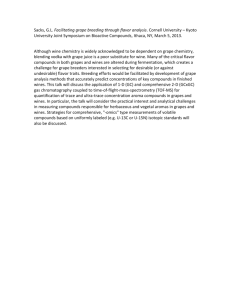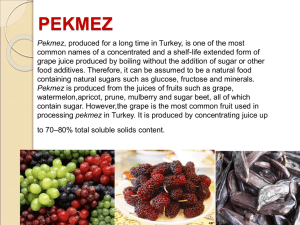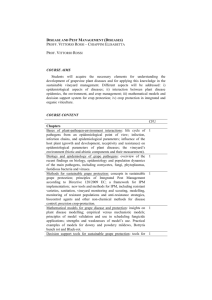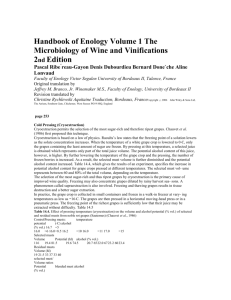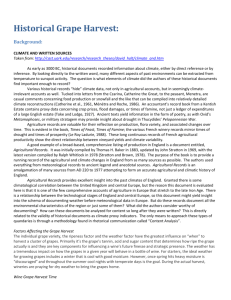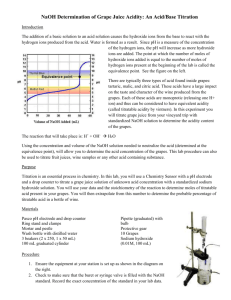Methomyl Target Pests - Southern Region IPM Center
advertisement
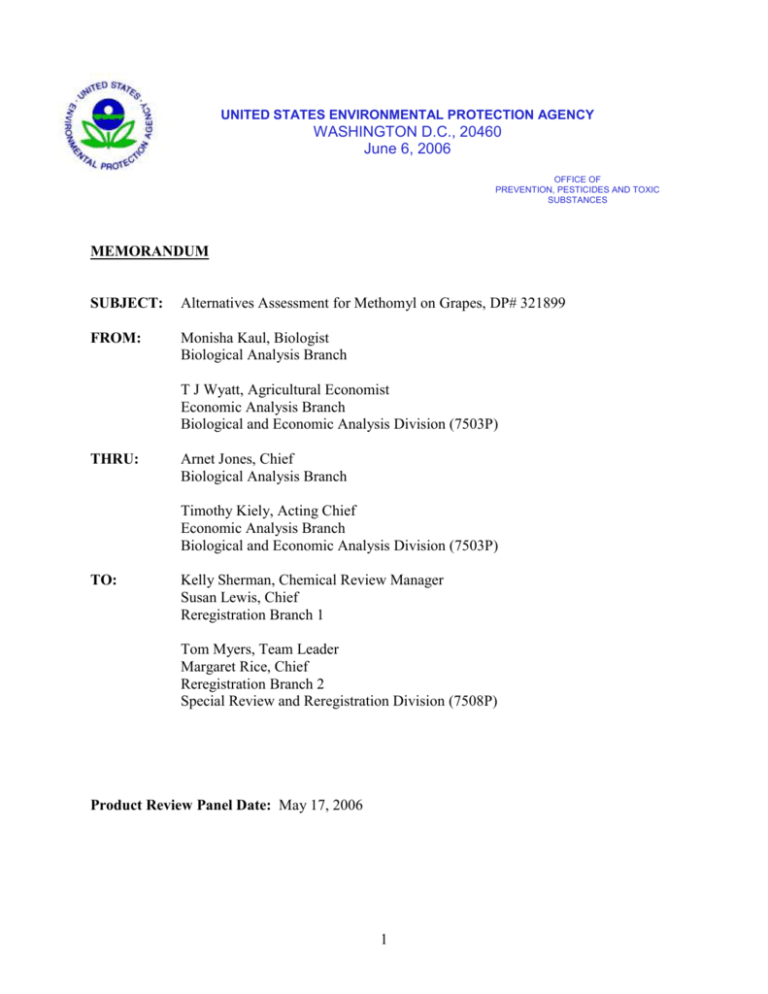
UNITED STATES ENVIRONMENTAL PROTECTION AGENCY WASHINGTON D.C., 20460 June 6, 2006 OFFICE OF PREVENTION, PESTICIDES AND TOXIC SUBSTANCES MEMORANDUM SUBJECT: Alternatives Assessment for Methomyl on Grapes, DP# 321899 FROM: Monisha Kaul, Biologist Biological Analysis Branch T J Wyatt, Agricultural Economist Economic Analysis Branch Biological and Economic Analysis Division (7503P) THRU: Arnet Jones, Chief Biological Analysis Branch Timothy Kiely, Acting Chief Economic Analysis Branch Biological and Economic Analysis Division (7503P) TO: Kelly Sherman, Chemical Review Manager Susan Lewis, Chief Reregistration Branch 1 Tom Myers, Team Leader Margaret Rice, Chief Reregistration Branch 2 Special Review and Reregistration Division (7508P) Product Review Panel Date: May 17, 2006 1 SUMMARY Methomyl is a systemic carbamate pesticide used on grapes to control several insects including leafhoppers, the omnivorous leafroller, the grape berry moth, and thrips. As part of the carbamate cumulative risk assessment, BEAD identified potential alternatives for the control of these pests. There appear to be alternatives for each of the target pests, although few provide control for the entire pest complex. BEAD has not quantified the impacts on growers of switching to alternatives. Production costs would likely rise, possibly substantially, but yield and quality are unlikely to be affected. In the Northeast, one of the most likely alternatives is carbaryl, another carbamate with broad-spectrum control and similar cost. BACKGROUND As part of the cumulative risk assessment for carbamate pesticides, BEAD is assessing the availability of alternative chemical and non-chemical control methods that may also be used to protect grapes from the main pests targeted by methomyl. This memo first discusses grape production and utilization. We then discuss methomyl usage and primary target pests. Finally, we examine possible alternatives with a discussion of advantages and disadvantages compared to methomyl. GRAPE PRODUCTION AND UTILIZATION Grapes are produced in nearly every state of the U.S. The most recent statistics indicate that about 940,000 acres of grapes are grown in the U.S. (USDA NASS, 2006). Over 85% of the total acreage is in California. Washington and New York are the other main producers. Total grape production is about 6.7 million tons annually with a total value of about $2.9 billion. Producer prices average around $430/ton, but vary considerably by state and by end use. Table 1 provides acreage, production and value figures as reported by USDA. Table 1. U.S. grape acreage, production and value, 2001 – 2005 average. Region Bearing Production Yield Value Acres (1000 tons) (ton/acre) ($1000) California 809,400 6,057.8 7.4 2,623,964 Pacific 61,720 351.8 5.7 169,463 Northwest 1 Northeast 2 58,380 311.9 5.3 76,460 South 3 8,900 23.9 2.7 22,596 U.S. 940,260 6,752.7 7.2 2,884,764 Price ($/ton) 435 485 245 945 425 Source: Noncitrus Fruits and Nuts Summary (USDA NASS, 2002-2005, 2006). U.S. totals do not equal the sum of the columns because some states are not included in the table. 1 Oregon and Washington. 2 Michigan, New York, Ohio, and Pennsylvania. 3 Arkansas, Georgia, Missouri, North Carolina, Texas, and Virginia. Grapes belong to the Vitaceae family. There are over 100 species, and many more varieties, identified in the literature. Grapes may be sold fresh or processed into juice, wine, raisins or 2 other products. Typically, certain varieties are targeted into specific uses, although there is some flexibility. For example, the Thompson seedless grape is considered a raisin variety (CDFA, 2006), although it may also be grown for the fresh market (table grapes) or crushed for wine, juice and other products. Wine is produced in all parts of the U.S. In contrast, raisins are almost completely produced in California. According to the Noncitrus Fruits and Nut Summary (USDA, 2002-2005, 2006), juice accounts for less than 10% of national production, but they are the dominant varietal types in the Pacific Northwest and the Northeast while California produces little or no juice varieties compared to other types. USDA data assume that all California grape tonnage crushed is used for wine. However, data from the California Department of Food and Agriculture (CDFA, 2002 - 2006) indicate that some of what USDA lists as wine is actually processed into other products including juice concentrate, juice not from concentrate, vinegar, brandy and other distilling materials as well as jams and jellies. About 16.3% of the grape crush (juice extraction), averaging about 600,000 tons between 2001 -2005, is used to make concentrate. Wine grapes make up the majority of the amount crushed. Raisin varieties, including Thompson seedless, make up about 13.5% of the total crush, while table grape varieties make up only 2.5%. Table 2 presents BEAD’s estimation of grape utilization, based on NASS and CDFA statistics. We assume that the amount of concentrate produced in California approximates the amount of grapes crushed for juice. Not all juice is made from concentrate, but concentrate may also be converted into other products. Table 2. Grape utilization, amount (tons) and percent of U.S. total, 2001 – 2005 average. Region Fresh Raisin Juice Wine and Other (% of total) (% of total) (% of total) (% of total) California 885,600 1,533,600 600,800 3,093,000 (98.8%) (98.3%) (56.9%) (81.2%) Pacific Northwest 1 219,400 131,000 (20.8%) (3.4%) Northeast 2 3,560 234,820 57,040 (0.4%) (22.3%) (1.5%) South 3 2,080 18,680 (0.2%) (0.5%) U.S. 896,420 1,560,570 1,055,020 3,806,960 Source: Noncitrus Fruits and Nuts Summary (USDA NASS, 2002-2005, 2006); Grape Crush Report (CDFA, 2002-2006). Totals may equal the sum of columns because of rounding or because minor uses are not reported. U.S. totals may not equal the sum of the columns because some states do not report specific utilization. 1 Oregon and Washington. 2 Michigan, New York, Ohio, and Pennsylvania. 3 Arkansas, Georgia, Missouri, North Carolina, Texas, and Virginia. 3 METHOMYL USE AND USAGE According to data from the California Pesticide Use Reports (CDFA, 2000-2005), methomyl use on wine grapes appears to have declined slightly between 1999 and 2004, from about three percent to about one percent of the acreage. Methomyl use on table and raisin grapes has been steady during this period, at about six percent of the bearing acreage treated. Reports do not distinguish between table and raisin grapes. Additional data from the National Agricultural Statistics Service, USDA (2000, 2002, 2004), indicate that methomyl is mainly applied to table grapes, with about 26% of table grape are treated. This may simply be an assumption on the part of USDA, since California data is sometimes categorized as “processed” and “other,” rather than “wine” and “other.” Thus, USDA may simply assume that anything not “processed” is fresh or table grape. However, other sources indicate that table grapes are more likely to be treated against some insect pests than are raisin grapes (California Grape Advisory Team, 2002). The total amount of methomyl applied to all grapes in California averages about 30,000 lb active ingredient (a.i.) (CDFA, 2000-2005; USDA NASS, 2000, 2002, 2004). There is typically one application per year, but about 20% of the acreage is treated multiple times. The average application rate is about 0.9 lb a.i./acre per year. The majority of methomyl is used on table and raisin grapes in California. On average, about 22,000 lb a.i. is applied at a rate of almost 0.95 lb a.i./acre per year. Rates appear to be declining, however, from about 1.2 lb a.i./acre in 1999 to about 0.75 lb a.i./acre in 2004. Data from other states are sparse. The National Agricultural Statistics Service, USDA (2000, 2002, 2004), surveys few states and publishes limited information. Methomyl use is reported throughout the country, but is not quantified. Outside California, most grapes are processed into wine or juice. Given that methomyl appears to be used primarily on table, and perhaps raisin, grapes, it would be consistent that little usage of methomyl would be observed in other states. However, there may be increases in methomyl usage as a result of recent restrictions on azinphos-methyl and possible restrictions on phosmet, two broad-spectrum organophosphates that target similar pests. METHOMYL TARGET PESTS California Leafhoppers Leafhoppers are a major pest of California grapes. Grape leafhoppers are a pest of the Central Valley, North Coast and Central Coast. The variegated leafhopper is a pest of southern California and the Central Coast. The grape leafhopper has one to two generations per year. The first generation is generally not treated so natural enemies may provide suppression (California Winegrape Work Group, 2004). The second generation feeds on actively growing leaves and, therefore, the most important period for monitoring and control is later in the season when fruit is developing (California Grape Advisory Team, 1999; California Minor Crops Council, 2003). High leafhopper populations can delay and reduce yield as well as lower fruit quality. 4 Thrips Grape and Western flower thrips are considered an important pest of California table grapes and a minor pest of wine grapes. Western flower thrips are generally more damaging than grape thrips (California Grape Advisory Team, 1999; California Grape Advisory Team, 2002). Adult and nymph Western flower thrip populations peak around bloom and are usually treated just after bud break, but may also be treated later. Thrips feed on growing shoot tips, which disfigure or stunt shoots (California Grape Advisory Team, 1999). Omnivorous Leafroller (OLR) The omivorous leafroller is a major pest of wine, table, and raisin grapes in California. This pest may cause serious damage in the Northern and Southern regions of the San Joaquin Valley. According to a previous assessment by BEAD (Cook and Kiely, 2001), “[The OLR] feeds on leaves, flowers, and developing berries. Damage to . . . berries allows rot organisms to enter the fruit. OLR larvae overwinter in old grape clusters (mummies) and vineyard weeds. In spring, the larvae complete their development and moths emerge and lay shingle-like egg masses on grape leaves. After about 5 days these eggs hatch, and larvae web together leaves or cluster parts to form a nest in which they feed.” Insecticides are generally not required until after bloom. According to the California Minor Crops Council (2003), the post-bloom period, but not immediately prior to harvest, is an important time to manage the OLR. Northeast Grape Berry Moth (GBM) The grape berry moth is a serious pest of wine and juice grapes in the Northeast. Up to three generations may emerge during the growing season, with later generations causing most of the damage by feeding on developing fruit (Cook and Kiely, 2001). Grape Leafhopper The grape leafhopper is also an important pest of wine and juice grapes. The grape leafhopper has one to two generations per year. Adults overwinter in litter on or near the vineyard floor. In mid to late June, eggs are laid on the underside of the grape leaf. Both adults and nymphs feed on the underside of grape leaves, which may result in leaf drop and reduced fruit quality if vines are heavily infested (Johnson, 2004). Control of the grape leafhopper coincides the timing of GBM control (Weigle, et al., 2000b). Pacific Northwest Although grape production in the Pacific Northwest is higher than the Northeast, there is little to no use of methomyl. Methomyl is available for control of cutworms and leafhoppers, which are important pests in Washington State wine grapes, but it is rarely used and considered too disruptive to non-target species (Western IPM Center, 2004). 5 CHEMICAL CONTROLS FOR TARGET INSECT PESTS California Less than half of wine and raisin vineyards receive treatments for grape and variegated leafhoppers, while most table grape vineyards are treated at least once per year (California Grape Advisory Team, 2002). Because the second generation of leafhoppers are potentially most damaging, this is the most crucial time for monitoring and control. Although methomyl provides good leafhopper control, it is highly toxic to predatory mites. Imidacloprid, of the chloronicotinyl family, is the most commonly used insecticide for leafhopper control because it is very effective and provides some residual control, although it has the potential for resistance (California Grape Advisory Team, 1999). Carbaryl and dimethoate also provide leafhopper control, but pose the same problem as methomyl; they are highly toxic to predatory mites. Table 3 provides a list of recommended controls of leafhoppers in California. 6 Table 3. Recommended controls and efficacy ratings for methomyl target pests in California1. Alternative Leafhoppers Thrips Omnivorous Leafroller F-G G Cost 2 $/acre 16.00 11.00 29.00 9.00 9.00 9.00 12.00 12.00 12.00 8.00 Methomyl E G Carbaryl F Imidacloprid E Dimethoate G F Endosulfan F Naled G Phosmet F F Fenpropahrin G Cryolite E Bacillus thuringiensis F Pheromone mating F-G disruptors2 Diazinon F 8.00 Methoxyfenozide E 16.00 Propargite F P P 28.00 Sources: California Minor Crops Council, 2003; California Grape Advisory Team, 1999. 1 This is not a comprehensive list of registered chemicals. The list includes only the registered alternatives recommended by the above sources. Efficacy ratings: E = Excellent, G = Good, F = Fair. 2 Average chemical cost per acre for treatment of target pests, 2001-2004, according to EPA proprietary data. Costs for non-chemical controls are not available. Western flower thrips occasionally require insecticide treatment in the spring if populations are high (California Grape Advisory Team, 1999; California Minor Crops Council, 2003). Methomyl provides good control of thrips, but may be harmful to beneficial organisms. There are relatively few good alternatives for thrips control (Table 3). According to the Pest Management Strategic Plan for Table Grape Production in California (California Minor Crops Council, 2003), fenpropathrin also provides good control of thrips. The OLR is mainly controlled using cryolite and Bacillus thuringiensis ( B.t.) in the spring. Broad spectrum organophosphates or carbamates, such as methomyl or carbaryl, are used for late season control if the OLR was not present in the spring (California Grape Advisory Team, 1999). EPA proprietary data indicate that impidicloprid is the most commonly used chemical control, used on about half the acres treated for the target pests, despite its relatively high cost. In comparison, methomyl is applied to less than five percent of the acres treated for the target pests. Fenpropathrin and propargite, with less than 10% of the acres treated for the target pests, are the next most commonly used chemical control. Northeast Chemical control of the GBM usually occurs post bloom when the first generation adult emerges. Treating the first generation generally keeps later generations under control. Applications may be repeated once or twice throughout the summer if needed. Table 4 lists the recommended controls of the GBM. In 2000, carbaryl was the most commonly used insecticide for GBM 7 control followed by methomyl (Weigle, et al., 2000a; Weigle, et al., 2000b). Since then additional chemicals have become available, such as fenpropathrin, bifenthrin, and methoxyfenozide. Carbaryl, methomyl, phosmet, fenpropathrin and bifenthrin are all highly effective against the GBM (Isaacs, 2005). Methoxyfenozide and Bacillus thuringiensis (B.t.) are effective selective insecticides (Isaacs, 2005), although methoxyfenozide is not registered for use in New York. Bacillus thuringiensis requires two applications for every one application of a conventional pesticide, which may make it less economically feasible (Weigle, et al., 2000a). Table 4. Recommended chemicals for methomyl target pests in the Northeast1. Alternative Methomyl Bacillus thuringiensis Carbaryl Phosmet Imidacloprid Pheromone mating disruptors Diazinon 3 Grape berry moth G G G-E G-E Grape Leafhopper G G-E F-G E Cost 2 $/acre 9.00 14.00 10.00 12.00 20.00 F G G-E G-E E F-G G Fenpropathrin 10.00 Methoxyfenozide 3 Bifenthrin 3 Acetamiprid 3 E Sources: Cornell University Cooperative Extension, 2006; Isaacs, 2005; Midwest Fruit Workers Group, 2006; Wise, et al., 2005; Weigle, et al., 2000a; Weigle, et al., 2000b. 1 This is not a comprehensive list of registered alternatives. The list includes only the registered alternatives recommended by the above sources. 2 Average chemical cost per acre for single treatment of target pests, 2001-2004, according to EPA proprietary data. Costs for non-chemical controls are not available. 3 Insufficient usage to estimate treatment cost. Insecticides for grape leafhopper control are only required if no GBM control is used. Leafhopper resistance to carbamates has been reported in some locations, so it is recommended that insecticides such as carbaryl and methomyl be avoided in these situations (Isaacs, 2005). Recommended chemical controls include imidacloprid, phosmet, fenpropathrin, and diazinon by Johnson (2004), while more recent guidelines suggest imidacloprid and acetamiprid provide excellent control of the grape leafhopper (Wise, et al., 2005). According to EPA proprietary data, carbaryl is the most commonly used chemical control, used on about half the acres treated for the target pests. In comparison, methomyl is applied to less than two percent of the acres treated for the target pests. Fenpropathrin, at about 30% of the acres treated for the target pests, is the second most commonly used chemical control. Azinphos-methyl and phosmet have been relatively important tools, applied to almost 10% and over 5% of the area treated for these pests, respectively, for the grape berry moth. However, azinphos-methyl use on grapes was cancelled in 2001, with growers allowed to use existing stocks through 2005. Growers may also face a longer restricted entry interval for phosmet, 8 which could lead growers to switch to alternative control methods. Some users of these organophosphates may switch to methomyl. NON-CHEMICAL CONTROLS FOR TARGET INSECT PESTS California Non-chemical controls for leafhoppers include basal leaf removal, weed control, sticky tape, and limiting vine growth (California Grape Advisory Team, 1999). Anagrus are predatory wasps that provide control of small populations of grape leafhoppers. Another predator, lacewings, may provide some control. Biological controls alone usually do not provide complete leafhopper control (California Grape Advisory Team, 1999). Little information is available on the cultural and biological control of thrips (California Grape Advisory Team, 1999). Because the OLR overwinters in old grape clusters on the vineyard floor, the old clusters should be removed or destroyed. Natural predators and parasitic species may also suppress OLR populations. It is recommended not to use chemicals harmful to these natural enemies (California Winegrape Work Group, 2004; California Grape Advisory Team, 1999). Northeast Pheromone mating disruptors are used around bloom when the first generation adult of the GBM emerges (Johnson, 2004). There is no effective, stand alone cultural or biological control, although leaf removal, weed control, and wild grape removal help with GBM control. There are no recommended cultural controls for the grape leafhopper and biological controls are limited (Weigle, et al., 2000b, 2000). CONCLUSION Methomyl is a broad-spectrum insecticide that primarily targets leafhoppers, thrips and leafrollers in California, and the grape berry moth and leafhopper in the Northeast. There appear to be alternative chemicals available to control these pests, although few provide control of the entire suite of pests and some pests, particularly thrips, have more limited control options. Production costs would likely increase if growers were forced to use other options, but yield and quality of grapes may not be affected. In the Northeast, the most likely alternatives include carbaryl, another carbamate with broad spectrum control and a similar cost. In recent years, broad-spectrum insecticides, such as carbamates, are being replaced by insecticides with a narrower activity spectrum. The older chemicals not only controlled the target pest(s), but also, most other exposed insects. A consequence of the shift to newer chemistries is that crop damage from insects that until recently were considered minor pests appears to be increasing. However concomitantly, the shift to narrower-spectrum chemicals may result in less mortality for beneficial species, including natural enemies, which should in turn 9 increase natural mortality for some insect pests, ultimately leading to less pesticide use. The final outcome may depend on the crop, region and pest complex. REFERENCES California Grape Advisory Team. 1999. Crop Profile for Grapes (Table) in California, December. Web address: http://www.ipmcenters.org/CropProfiles/docs/cagrapestable.html California Grape Advisory Team. 2002. Crop Profile for Grapes (Wine) in California, February, revised. Web address: http://www.ipmcenters.org/cropprofiles/docs/cagrapes-wine.html California Minor Crops Council. 2003. A Pest Management Strategic Plan for Table Grape Production in California, November. Web address: http://www.ipmcenters.org/pmsp/pdf/CATableGrapes.pdf. California Winegrape Work Group. 2004. A Pest Management Strategic Plan for Winegrapes in California, November. Web address: http://www.ipmcenters.org/pmsp/pdf/cawinegrapes.pdf CDFA (California Dept. of Food and Agriculture). 2002 - 2006. Final Grape Crush Report. California Department of Food and Agriculture, Sacramento, March, at http://www.nass.usda.gov/ca/bul/crush/indexgcb.htm CDFA (California Dept. of Food and Agriculture). 2000-2005. Usage of Agricultural Pesticides in California: Pesticide Usage Report. California Department of Food and Agriculture, Sacramento, at http://www.ipm.ucdavis.edu/PUSE/puse1.html . Cook, C. and T. Kiely, 2001. Grape Benefits Assessment for Azinphos-methyl and Phosmet. EPA unpublished report. Web address: http://www.epa.gov/pesticides/op/phosmet/bead_Grapes1.pdf. Cornell University Cooperative Extension, 2006. 2006 New York and Pennsylvania pest management guidelines for grapes. Web address: http://ipmguidelines.org/grapes/4_InsectManagement.htm. Isaacs, R., 2005. Early-season grape berry moth management. Michigan State University Fruit Crop Advisory Team Alert, 20(7). Web address: http://www.ipm.msu.edu/CAT05_frt/F05-24-05.htm#4. Johnson, H. 2004. Crop Profile for Lubrusca (Juice) Grapes in Michigan, Michigan State University, January. Web address: http://www.ipmcenters.org/cropprofiles/docs/MIlabruscagrapes.html Midewest Fruit Workers Group, 2006. Midwest commercial small fruit and grape spray guide 2006. Web Address: http://www.hort.purdue.edu/hort/ext/sfg/06SprayGuide.pdf. 10 USDA NASS. 2006. Noncitrus Fruits and Nuts, 2005 Preliminary Summary. National Agricultural Statistics Service, U.S. Department of Agriculture, January, at http://usda.mannlib.cornell.edu/reports/nassr/fruit/pnf-bb/ncit0106.pdf. USDA NASS. 2000-2005. Noncitrus Fruits and Nuts, Summary. National Agricultural Statistics Service, U.S. Department of Agriculture, July, at http://usda.mannlib.cornell.edu/reports/nassr/fruit/pnf-bb/ USDA NASS. 2000, 2002, 2004. Agricultural Chemical Usage, Fruit Summary. National Agricultural Statistics Service, U.S. Department of Agriculture, at http://usda.mannlib.cornell.edu/reports/nassr/other/pcu-bb/#fruits Weigle, T., G. English-Loeb, W. Wilcox, R. Dunst, B. Shaffer, and Lake Erie Processors Group. 2000. Crop Profile for Grapes (Labrusca) in New York, May, available at http://www.ipmcenters.org/cropprofiles/docs/nygrapes-labrusca.html. Weigle, T., G. English-Loeb, W. Wilcox, R. Dunst, B. Shaffer, T. Mitchell and T. Collins. 2000. Crop Profile for Grapes (Vinefera and French Hybrid) in New York, May, available at http://www.ipmcenters.org/cropprofiles/docs/nygrapes-vineferaandfrenchhybrid.html. Western IPM Center. 2004. A Pest Management Strategic Plan for Washington State Wine Grape Production, May. Web address: http://www.ipmcenters.org/pmsp/pdf/WAWineGrapePMSP.pdf Wise, J., A. Hanley, R. Lamb, M. Haas, L. Duynslager, 2005. 2006 Michigan fruit management guide. Michigan State University, Extension Bulletin E-154. Web address: http://web1.msue.msu.edu/epubs/pestpubs/E154/1-TOC.pdf. 11
